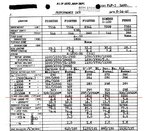Shortround6
Lieutenant General
I have voiced this theory before and have nothing to back it up but here it is again.
In 1939 and part of 1940 the American .50 cal cycled at 600rpm and that is on test stands. In actual aircraft the cycle rate some times fell to 500rpm and that is for UN-synchronized guns. At some point in 1940 the guns were up-graded to the 800-850rpm rate of fire standard.
It might depend on WHEN the British made their request for the 6 guns. Six X 10rps= 60 rps. four X 14rps= 56rps. Given the number of months it took to get a modification for drawing board to service squadron some overlap of when the guns were upgraded might be an explanation.
In 1939 and part of 1940 the American .50 cal cycled at 600rpm and that is on test stands. In actual aircraft the cycle rate some times fell to 500rpm and that is for UN-synchronized guns. At some point in 1940 the guns were up-graded to the 800-850rpm rate of fire standard.
It might depend on WHEN the British made their request for the 6 guns. Six X 10rps= 60 rps. four X 14rps= 56rps. Given the number of months it took to get a modification for drawing board to service squadron some overlap of when the guns were upgraded might be an explanation.

